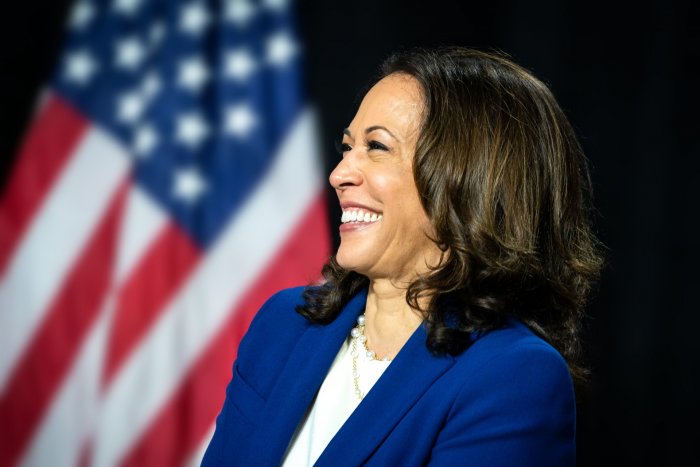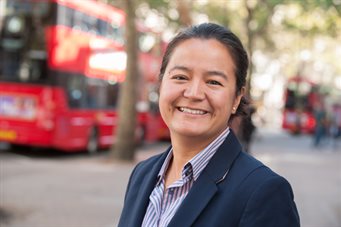Writing for the Chartered Association of Business Schools, in this blog, Professor Sally Everett proposes steps to make female leadership more equal across business schools.
I was in tears on Saturday 7 November – moved by emotion, excitement and sheer relief. Watching the first woman ever to be elected to the office of Vice President of the United States of America was to me, one of the most momentous and important historic events I have witnessed in my lifetime. As Kamala Harris spoke, it gave me hope for women and the future of leadership (in all its forms) everywhere:
“Dream with ambition, lead with conviction and see yourselves in a way that others may not simply because they’ve never seen it before“ (Kamala Harris, 7/11/20)

Kamala Harris, who was recently elected as the first ever black, Asian, and female Vice-President of the United States of America.
It got me thinking; what might this ‘dreaming with ambition’ look like for women (and especially women of colour) seeking leadership in our business schools? How might women be able to lead with conviction and pave the way for future female academic leaders, history makers and ultimately help realise equity and genuine diversity within our leadership communities?
As a member of the Chartered ABS Equality, Diversity and Inclusion Committee it seems an opportune moment to suggest some actions that might deliver improved female representation and diversity across all levels of leadership. At the time of writing, 43 business schools have a female Dean/Director (out of 120 Chartered ABS member business schools) and although 35.8% is perhaps a more encouraging statistic than some other faculties and schools, it hides some glaring inequalities in terms of equality of pay, opportunity, and recognition as reported in a Chartered ABS research reflection on HESA data and Hewitt for HEPI (2020).
I propose we consider seven areas of action that could make a positive difference and shift the dial towards greater female representation in all forms and levels of business school leadership. For ease, I have summarised these as ‘Seven Ts’ for transforming women’s leadership in business schools. I am most grateful to the Plus Alliance working group and work of the Chartered ABS EDI Committee for planting seeds in me; seeds and shoots that will continue to grow over time and inform my entire career.
I offer seven steps to gender equity in our schools: tone, transform, talk, togetherness, transparent, talent, and targets.
- TONE: We need the ‘tone from the top’ and be convinced that our leaders care about this agenda and are prepared to act. Not because of how it might look, or that it might help secure research funding, but because they ‘get it’, understand the urgency of it and want to champion gender equity for the sake of the whole community. University and faculty leaders must set the tone through their actions, their language, and their policies. We look to our leaders for guidance and inspiration. Much like we know gender parity will not happen on its own in the boardroom (Thorne and Konigsburg writing in HBR 2020), leaders at the top of our institutions need to actively and visibly empower women. Who are they appointing to the executive council and board? Are they our school’s/university’s equality and diversity champions? Are they sponsoring female colleagues?
- TRANSFORM: In reframing leadership we need to ensure invisible work (often unhelpfully called ‘admin’ or ‘service’) is valued. For many, academic leadership has become synonymous with invisible administration, long hours and under appreciation. Schools need to foster a culture where academic citizenship is rewarded and recognised in probation, promotion and professorial criteria. Female faculty will often take on a disproportionate amount of this work (see Guarino and Borden, 2017 who found women took on 30 more minutes per week of service than men and 1.5 more service activities per year than men). How are Business Schools complicit in this? For example, student support interventions at programme level that retain students can be worth millions of pounds in fee income, or the development of a new course can secure significant sums of recruitment income, yet an external research grant worth a fraction of this is often more openly celebrated and regarded as more critical for promotion. We also need to ensure there is parity in how we treat research and teaching – when a colleague secures a research fellowship or sabbatical, someone covers their teaching. Who covers someone’s research when they secure a teaching fellowship?
- TALK: as we have seen in the recent Black Lives Matter movement, we recognise that silence is compliance. We all have a duty to champion our colleagues and ensure we call out sexism, address gender inequality, and expose misogyny where and when we see it. Many of us have seen committee papers and research written by female colleagues skilfully repurposed to remove their input; we need to expose such behaviour and start talking to others when and where this happens. It cannot be left unsaid. We need to be the cheerleaders of our female colleagues in our business school meetings.
- TOGETHERNESS: we need to create ties and come together in networks. In developing a growth mindset where we bring each other along (and elevate up) leaders become navigators to those seeking guidance and support. Echoing Granovetter’s groundbreaking sociological study ‘Strength of Weak Ties’ work (1973), we know women generally develop deeper relationships and less ‘loose ties’. We need to develop communities of practice where we nurture links, share experiences, and build a sense of belonging. In my own business school, I was struck by some of the career isolation many of female colleagues shared with me, so developed ‘Women@KBS’ as a network of sharing ideas, support and reflections. It has become a place of nurturing and empowerment.
- TRANSPARENCY: we need to reward and recognise where the work is happening and hold our schools to account by publishing data about equality performance. We need to go beyond traditional measures of leadership and be more transparent in what is measured, why and by whom. For example, perhaps we should openly acknowledge who is at the table in terms of equality and diversity at the start of our meetings, and report the number of women and faculty from under-represented groups in our annual reports and in our committee minutes.
- TALENT: we need to identify talent, create a talent pool and sponsor the development of colleagues. How might we expose female colleagues to ‘doing’ leadership through vertical shadowing, peer mentoring, and bring women to the executive table as part of succession planning? The recent Chartered ABS mentoring scheme was an important step in this direction. By creating explicit pathways to leadership and recognising work with titles for their CV e.g. Director of X, Lead of Y we create opportunities for those around us to emerge and to excel. Consider having female colleagues shadow the Dean for a period of time in rotation, or think about what role titles could be used for colleagues involved in academic administration tasks that fall within the cracks of an ineffective workload model, e.g. Academic Lead for Community Engagement.
- TARGETS: ensure equity-based KPIs are woven into performance reviews. Peter Drucker famously said, ‘if you can’t measure it, you can’t improve it’. We need to be transparent in how we use data and be ambitious in the targets we set ourselves and our schools. We need to measure impact quantitatively and publish data at school level (as we see in the Athena Swan approach), but also ensure we capture impact qualitatively through personal stories, lived experiences and people’s reflections.
Equality in our business schools will not happen by chance –We need to be pro-active and fill the spaces where decisions happen in our schools with a dialogue of diversity and inclusion. As a Vice Dean of a business school I have a strong sense of responsibility to pay it forward and to create a ripple effect. We know that everyone benefits when women are included. It will be about evolution not revolution, but we need to commit to the the legacy we wish to build, and start now. As we look at female leadership, I am inspired by global figures like Kamala Harris, Michelle Obama, Ruth Bader Ginsburg, and Jacinda Ardern who have sought to advance others through strength and empathy and lead others through kindness, decency and respect.
‘Women belong in all places where decisions are being made’ (Ruth Bader Ginsburg)
References
Granovetter, M. S. (1973). The strength of weak ties. American journal of sociology, 78(6), 1360-1380. Available from : https://www.cse.wustl.edu/~m.neumann/fl2017/cse316/materials/strength_of_weak_ties.pdf
Guarino, C.M., and Borden, V.M.H. (2017) Faculty Service Loads and Gender: Are Women Taking Care of the Academic Family?. Research in Higher Education 58, 672–694 (2017). https://doi.org/10.1007/s11162-017-9454-2
Hewitt, R. (2020) Mind the gap: gender differences in higher education, HEPI Report 2020. Available from: https://www.hepi.ac.uk/2020/03/07/mind-the-gap-gender-differences-in-higher-education/
Thorne, S. and Konigsburgh, D. (2020) Gender Parity in the Boardroom Won’t Happen on Its Own in Harvard Business Review 12 February 2020. Available from: https://hbr.org/2020/02/gender-parity-in-the-boardroom-wont-happen-on-its-own
World Economic Forum (2020) Mind the 100 Year Gap. Available from: https://www.weforum.org/reports/gender-gap-2020-report-100-years-pay-equality
 Professor Sally Everett is a Professor of Business Education, and Vice Dean (Education) at King’s Business School, where she leads on the development, implementation and promotion of the King’s Business School’s education strategy.
Professor Sally Everett is a Professor of Business Education, and Vice Dean (Education) at King’s Business School, where she leads on the development, implementation and promotion of the King’s Business School’s education strategy.